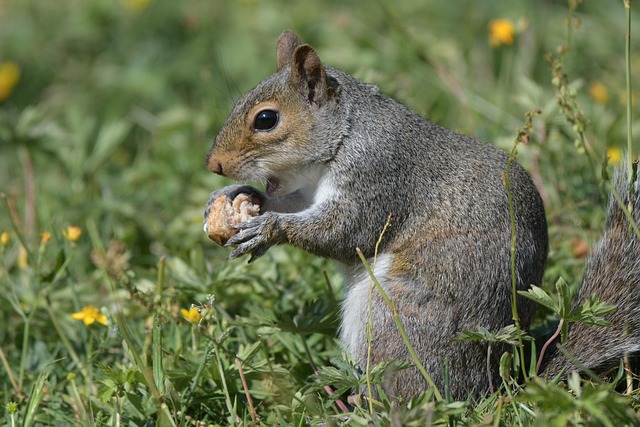Understanding squirrel behavior is key to implementing effective and humane squirrel control. Squirrels are intelligent and agile, learning from experiences and adept at finding food. To redirect them away from bird feeders, use techniques like protective netting, positioning feeders strategically, and offering alternative food sources. Humane squirrel control methods focus on coexistence while protecting outdoor spaces. Non-toxic deterrents, physical barriers, and specialized squirrel-proof feeders are effective tools. For persistent issues, seek professional services that employ advanced techniques like habitat modification and live trapping to ensure the well-being of both squirrels and other wildlife.
Protecting bird feeders and outdoor spaces from squirrels can be a challenge, but understanding their behavior is key to implementing effective, humane squirrel control methods. This comprehensive guide explores non-toxic deterrents, physical barriers, and professional help versus DIY solutions. Learn how to create a harmonious environment that keeps squirrels at bay while ensuring the well-being of these furry creatures. Discover the best practices for maintaining your outdoor sanctuary without resorting to harmful tactics.
Understanding Squirrel Behavior: Key to Humane Control
Understanding squirrel behavior is key to implementing effective and humane squirrel control methods. These creatures are highly intelligent, agile, and resourceful, making them adept at finding food sources. They have excellent memory and learn from experiences, which means traditional deterrents alone may not be enough. Observing their habits and preferences can help you devise strategies that disrupt their feeding patterns without causing harm.
Squirrels often target bird feeders due to the readily available food source. By using humane techniques such as installing protective netting or caps on feeders, positioning them away from trees, and offering alternative food sources in nearby areas, you can encourage squirrels to seek sustenance elsewhere. It’s important to remember that squirrels play a vital role in ecosystems, so any control measures should aim to coexist with them as much as possible while protecting your outdoor spaces.
Non-Toxic Deterrents: Protecting Your Bird Feeders
Squirrels can be a nuisance, especially for bird feeder enthusiasts. While it might be tempting to use toxic substances as deterrents, opting for humane squirrel control methods is not only safer for your feathered friends but also for the environment and other wildlife. Non-toxic deterrents like scent repellents, visual deterrents, and physical barriers are effective in keeping squirrels at bay without causing harm.
Scent-based deterrents, such as those containing capsaicin (a component of chili peppers), can effectively discourage squirrels due to their sensitivity to strong odors. Visual deterrents like reflective objects or motion-activated sprinklers startle squirrels, making them wary of the area. Physical barriers, including mesh netting or sturdy cages, are also humane options that prevent squirrels from accessing bird feeders while allowing birds to enjoy their meals undisturbed.
Physical Barriers: Designing Squirrel-Resistant Outdoor Spaces
Creating a squirrel-resistant outdoor space is an effective approach to humane squirrel control, ensuring these playful creatures don’t disrupt your bird feeder arrangements or cause damage to your yard. Physical barriers are a popular and environmentally friendly method to deter squirrels. One of the simplest techniques involves using tall fences around your bird feeders and gardens. Since squirrels are excellent climbers, a fence should be at least 8–10 feet (2.4–3 meters) high, made from a sturdy material like metal or heavy-duty plastic. This physical barrier will prevent squirrels from accessing the area, allowing birds to feed undisturbed.
Additionally, you can install specialized squirrel-proof feeders designed with unique entry mechanisms. These feeders use weighted platforms or spinning perches that activate when a bird lands, ensuring only feathered visitors can enter. Another creative solution is to attach reflective objects like old CDs or aluminum pie plates to the fence or tree branches above bird feeders. The reflection and movement of these items deter squirrels as they prefer to avoid potential predators in their environment.
Professional Help vs. DIY Solutions: When to Seek Assistance
When dealing with persistent squirrel infestations, many homeowners wonder where to draw the line between DIY solutions and seeking professional help. While some methods like scaring tactics or simple physical barriers can be effective for minor issues, a serious problem may require more specialized knowledge and tools.
Professional humane squirrel control services offer advanced techniques such as habitat modification, exclusion strategies, and live trapping, ensuring the well-being of both squirrels and other wildlife. These experts have the experience to identify entry points, understand squirrel behavior, and implement long-term solutions tailored to your specific situation. If your bird feeders are constantly under attack or squirrels have made your outdoor space their home, considering professional assistance is a wise decision to protect your investment and enjoy your outdoor haven without unwanted guests.
Protecting bird feeders and outdoor spaces from squirrels requires a combination of understanding their behavior, employing non-toxic deterrents, and implementing physical barriers. By choosing humane squirrel control methods, you can enjoy your outdoor spaces without causing harm to these mischievous creatures. Whether through DIY solutions or professional assistance, there are options available for every need and budget. Remember, a balanced approach that respects both wildlife and human needs is key to creating a harmonious environment.
